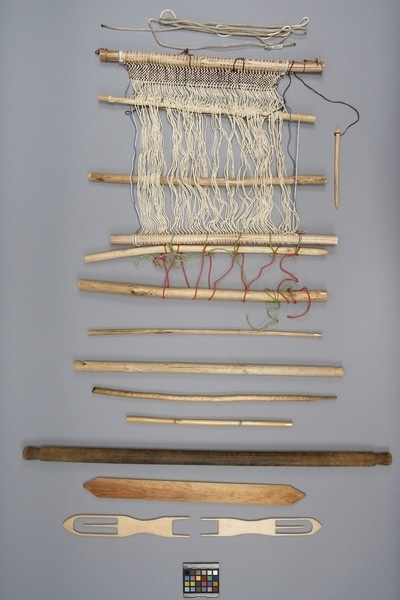Loom Item Number: Sa269 a-n from the MOA: University of British Columbia

Description
Demonstration backstrap loom (part a) with various attached and/or removable pieces (parts b-n). Part a: loom with front and back wooden loom bars with natural multi-ply cotton string warps attached; strings in dyed green and orange interwoven along inside edges of bars; dyed brown weft string interwoven for 13 rows of plain weave, the end of the weft yarn is attached to a pointed stick which is notched for attached yarn at other end. Dyed blue string attached to loom bars and interwoven to lengthwise selvedges. Part b: slightly curved heddle rod of shaved beige stick tied and wrapped by warp from weaving. Part c: separate shaved beige lease stick or bobbin with angled ends and longitudinal splits. Part d: slightly curved shed stick loosely resting in warp. Part e: separate wooden stick loom bar with knotted end. Part f: lease stick with numerous pin point holes, a rounded end, split 4.5 cm. in from end, other end is burnt and beveled. Part g: bamboo lease stick or heddle rod. Part h: separate wooden batten sword with pointed, triangular ends, rounded along one length, tapering to other side. Part i: separate large dark wooden loom bar with notched ends. Parts j and k: wooden support sticks around which green and orange string is attached. Green string loops (tied and glued) hold j to loom bar farthest from weaving. Part l: separate grey/white synthetic rope, burnt at ends with single knot near one end. Parts m and n: carved light wooden shuttles with pointed ends, carved out section with pointed stick through centre, two points at other end, 'J.L.' carved near end.
History Of Use
Back strap looms have been used since pre-Columbian times in Central America. This relatively simple loom can be tied to a tree or a house post, while a strap at the other end passes around the weaver's waist. The loom is suspended at an angle to allow the weaver maximum control over the weaving. The loom consists of 2 bars around which the horizontal (warp) threads are wrapped, and a series of vertical sticks to aid in the insertion of the vertical (weft) elements of the cloth. The portability of these looms allows the women who use them to work at home or move the weaving to a neighbour's, or outside while tending flocks etc. (Anderson). They are also inexpensive, therefore, most women can afford to weave, and weaving is often integrated with other household tasks. Textiles produced on back strap looms were traditionally used to produce clothes for the family, especially huipils, belts, sashes and tzutes. Now many families derive an important part of their income by selling to outside markets. Women primarily use back strap looms, whereas, men are primarily employed on treadle looms in textile production.
Cultural Context
weaving
Item History
- Made in Guatemala
- Collected during 1976
- Owned by Inge Ruus before August 5, 1977
- Received from Inge Ruus (Seller) and Museum of Anthropology Donations Fund (Funding source) on August 5, 1977
What
- Name
- Loom
- Identification Number
- Sa269 a-n
- Type of Item
- loom
- Material
- wood, cotton fibre, adhesive, synthetic, dye and bamboo grass
- Manufacturing Technique
- cut, wrapped, burned, glued, woven, tied, shaved, dyed and carved
- Part A
- height 54.0 cm, width 50.3 cm
- Part B
- height 48.7 cm, diameter 1.0 cm
- Part C
- height 52.4 cm, diameter 0.8 cm
- Part D
- height 53.1 cm, diameter 1.7 cm
- Part E
- height 59.5 cm, diameter 2.0 cm
- Part F
- height 54.7 cm, diameter 1.4 cm
- Part G
- height 37.1 cm, diameter 1.0 cm
- Part H
- height 50.2 cm, width 4.5 cm, depth 1.0 cm
- Part I
- height 81.6 cm, diameter 3.2 cm
- Part J
- height 53.8 cm, diameter 1.5 cm
- Part K
- height 54.8 cm, diameter 2.2 cm
- Part L
- height 297.6 cm, width 0.4 cm
- Part M
- height 29.1 cm, width 4.6 cm, depth 0.4 cm
- Part N
- height 27.5 cm, width 3.7 cm, depth 0.4 cm
Who
- Culture
- Maya ?
- Previous Owner
- Inge Ruus
- Received from
- Inge Ruus (Seller) and Museum of Anthropology Donations Fund (Funding source)
Where
- Holding Institution
- MOA: University of British Columbia
- Made in
- Guatemala
When
- Collection Date
- during 1976
- Ownership Date
- before August 5, 1977
- Acquisition Date
- on August 5, 1977
Other
- Item Classes
- textiles
- Condition
- good
- Accession Number
- 0404/0046 a-n